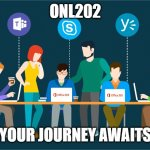If my Calendar serves my memory correct it has been 12 weeks since I enrolled for ONL201 and every week has its own challenges and accomplishments. Now we have reached the end of our ONL201 journey and it has been nothing short of greatness and wealth of knowledge and experience. I would not substitute this experience for anything in the world as it has been a revelation of the current unprecedented times we are facing globally (COVID19).
Never did I imagine myself taking part in an Online Collaborative learning course as this tapped on my biggest fear of using and exploring digital collaborative tools and technology, let alone being put in a group with people from different countries and the only form communication was through an online collaborative platform or social platform. Now this was enough reason to scare me away and probably deregister from the course, but I decided to challenge myself and stop boxing myself from old traditional ways of learning. What I have taken away from this course is how valuable and important communication and trust is amongst any group of learners. This has given me the opportunity to be more open about my opinions and not shy away thinking that my idea is a stupid idea. This course has shown me the power of being able to share my ideas and opinions as this has helped with structure and giving multiple ways of solving a problem that you had no answers to.
Without any doubt my views on teaching practices have changed for the better and I intend to put all this knowledge in practice going forth and also try to convince my colleagues to explore more of the digital tools that I have been exposed to such as Prezi, Coggle, padlet just to name a few. I definitely think online collaborative tools are the new classrooms and therefore should embrace it more as many institutions are shifting to Blended Learning.
With all of the above mentioned I would like to say to the upcoming ONLers that, they need to be ready to soak up all the information and knowledge they about to bump into as it is for their benefit. In the beginning it may seem this is all too much but the key is to keep going and I promise it gets easier. A tip: Give yourself enough time for the readings and do not feel the pressure of trying to read everything all at once as this can be frustrating. There is no doubt that time will be of the essence and you will need to use it wisely as you try to balance your day to day work hours with the ONL course.

